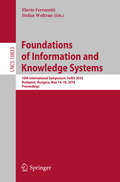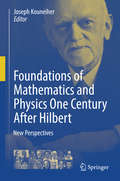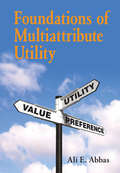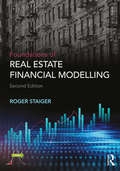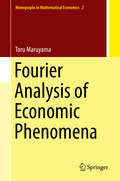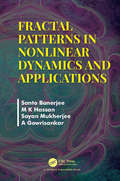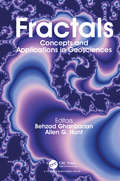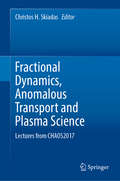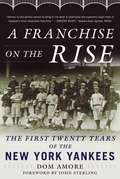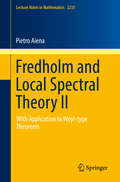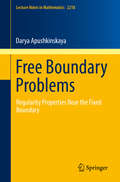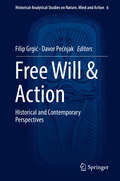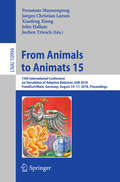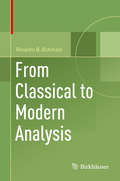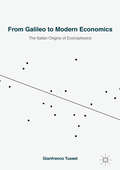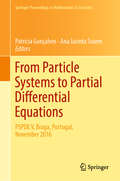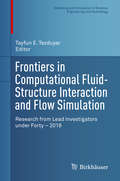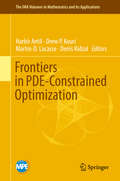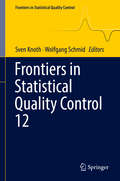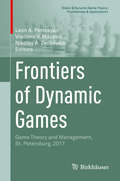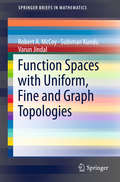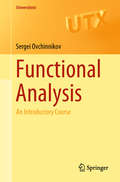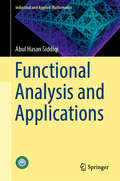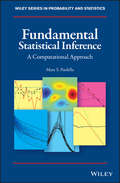- Table View
- List View
Foundations of Information and Knowledge Systems: 10th International Symposium, Foiks 2018, Budapest, Hungary, May 14-18, 2018, Proceedings (Lecture Notes in Computer Science #10833)
by Flavio Ferrarotti Stefan WoltranThis book constitutes the refereed proceedings of the 10th International Symposium on Foundations of Information and Knowledge Systems, FoIKS 2018, held in Budapest, Hungary, in May 2018.The 20 revised full papers presented together with 1 invited talk were carefully reviewed and selected from 40 submissions. The papers address various topics such as big data; database design; dynamics of information; information fusion; integrity and constraint management; intelligent agents; knowledge discovery and information retrieval; knowledge representation, reasoning and planning; logics in databases and AI; mathematical foundations; security in information and knowledge systems; semi-structured data and XML; social computing; the semantic web and knowledge management; and the world wide web.
Foundations of Mathematics and Physics One Century After Hilbert: New Perspectives
by Joseph KouneiherThis book explores the rich and deep interplay between mathematics and physics one century after David Hilbert’s works from 1891 to 1933, published by Springer in six volumes. The most prominent scientists in various domains of these disciplines contribute to this volume providing insight to their works, and analyzing the impact of the breakthrough and the perspectives of their own contributions. The result is a broad journey through the most recent developments in mathematical physics, such as string theory, quantum gravity, noncommutative geometry, twistor theory, Gauge and Quantum fields theories, just to mention a few. The reader, accompanied on this journey by some of the fathers of these theories, explores some far reaching interfaces where mathematics and theoretical physics interact profoundly and gets a broad and deep understanding of subjects which are at the core of recent developments in mathematical physics. The journey is not confined to the present state of the art, but sheds light on future developments of the field, highlighting a list of open problems. Graduate students and researchers working in physics, mathematics and mathematical physics will find this journey extremely fascinating. All those who want to benefit from a comprehensive description of all the latest advances in mathematics and mathematical physics, will find this book very useful too.
Foundations of Multiattribute Utility
by Ali E. AbbasMany of the complex problems faced by decision makers involve uncertainty as well as multiple conflicting objectives. This book provides a complete understanding of the types of objective functions that should be used in multiattribute decision making. By using tools such as preference, value, and utility functions, readers will learn state-of-the-art methods to analyze prospects to guide decision making and will develop a process that guarantees a defensible analysis to rationalize choices. Summarizing and distilling classical techniques and providing extensive coverage of recent advances in the field, the author offers practical guidance on how to make good decisions in the face of uncertainty. This text will appeal to graduate students and practitioners alike in systems engineering, operations research, business, management, government, climate change, energy, and healthcare.
Foundations of Real Estate Financial Modelling
by Roger StaigerFoundations of Real Estate Financial Modelling, Second Edition is specifically designed to provide the scalable basis of pro forma modelling for real estate projects. The book introduces students and professionals to the basics of real estate finance theory prior to providing a step-by-step guide for financial real estate model construction using Excel. The book introduces an innovative new financial metric, P(Gain), which quantifies the probability of a Return of Capital and answers the most basic question for investing, "What is the probability I get my money back?".? This new second edition has been fully revised and expanded. The book is separated into three functional units: (1) Real Estate Valuation Basics, Theory and Skills, (2) Real Estate Pro Forma Modelling, (3) Real Estate Pro Forma (Enhancements). New and enhanced Chapters cover:? Interest rates Amortization Single- and multi-family unit Development module Rent roll module Waterfall (equity bifurcation) Hotel, retail/office and townhouse. ? In addition, this new edition includes problem sets and solutions at the end of each chapter as well as case studies underpinning the chapter topics. Further chapters are dedicated to risk quantification and include scenario, stochastic and Monte Carlo simulations, equity waterfalls, and adding U.S. GAAP financial statements to existing real estate pro forma models. This book is the ideal textbook for a Real Estate Finance class, providing the theoretical basis of real estate finance as well as valuable modelling skills for the workplace. This book provides individuals with a step-by-step instruction on how to construct a real estate financial model starting with a new spreadsheet. The resultant model is portable, scalable, and modular. A companion website provides the pro forma models to readers as a reference for their own constructed models.
Fourier Analysis of Economic Phenomena (Monographs in Mathematical Economics #2)
by Toru MaruyamaThis is the first monograph that discusses in detail the interactions between Fourier analysis and dynamic economic theories, in particular, business cycles.Many economic theories have analyzed cyclical behaviors of economic variables. In this book, the focus is on a couple of trials: (1) the Kaldor theory and (2) the Slutsky effect. The Kaldor theory tries to explain business fluctuations in terms of nonlinear, 2nd-order ordinary differential equations (ODEs). In order to explain periodic behaviors of a solution, the Hopf-bifurcation theorem frequently plays a key role. Slutsky's idea is to look at the periodic movement as an overlapping effect of random shocks. The Slutsky process is a weakly stationary process, the periodic (or almost periodic) behavior of which can be analyzed by the Bochner theorem. The goal of this book is to give a comprehensive and rigorous justification of these ideas. Therefore, the aim is first to give a complete theory that supports the Hopf theorem and to prove the existence of periodic solutions of ODEs; and second to explain the mathematical structure of the Bochner theorem and its relation to periodic (or almost periodic) behaviors of weakly stationary processes.Although these two targets are the principal ones, a large number of results from Fourier analysis must be prepared in order to reach these goals. The basic concepts and results from classical as well as generalized Fourier analysis are provided in a systematic way.Prospective readers are assumed to have sufficient knowledge of real, complex analysis. However, necessary economic concepts are explained in the text, making this book accessible even to readers without a background in economics.
Fractal Patterns in Nonlinear Dynamics and Applications: Patterns in Nonlinear Dynamics and Applications
by Santo Banerjee M K Hassan Sayan Mukherjee A GowrisankarMost books on fractals focus on deterministic fractals as the impact of incorporating randomness and time is almost absent. Further, most review fractals without explaining what scaling and self-similarity means. This book introduces the idea of scaling, self-similarity, scale-invariance and their role in the dimensional analysis. For the first time, fractals emphasizing mostly on stochastic fractal, and multifractals which evolves with time instead of scale-free self-similarity, are discussed. Moreover, it looks at power laws and dynamic scaling laws in some detail and provides an overview of modern statistical tools for calculating fractal dimension and multifractal spectrum.
Fractals: Concepts and Applications in Geosciences
by Behzad Ghanbarian Allen G. HuntThis book provides theoretical concepts and applications of fractals and multifractals to a broad range of audiences from various scientific communities, such as petroleum, chemical, civil and environmental engineering, atmospheric research, and hydrology. In the first chapter, we introduce fractals and multifractals from physics and math viewpoints. We then discuss theory and practical applications in detail. In what follows, in chapter 2, fragmentation process is modeled using fractals. Fragmentation is the breaking of aggregates into smaller pieces or fragments, a typical phenomenon in nature. In chapter 3, the advantages and disadvantages of two- and three-phase fractal models are discussed in detail. These two kinds of approach have been widely applied in the literature to model different characteristics of natural phenomena. In chapter 4, two- and three-phase fractal techniques are used to develop capillary pressure curve models, which characterize pore-size distribution of porous media. Percolation theory provides a theoretical framework to model flow and transport in disordered networks and systems. Therefore, following chapter 4, in chapter 5 the fractal basis of percolation theory and its applications in surface and subsurface hydrology are discussed. In chapter 6, fracture networks are shown to be modeled using fractal approaches. Chapter 7 provides different applications of fractals and multifractals to petrophysics and relevant area in petroleum engineering. In chapter 8, we introduce the practical advantages of fractals and multifractals in geostatistics at large scales, which have broad applications in stochastic hydrology and hydrogeology. Multifractals have been also widely applied to model atmospheric characteristics, such as precipitation, temperature, and cloud shape. In chapter 9, these kinds of properties are addressed using multifractals. At watershed scales, river networks have been shown to follow fractal behavior. Therefore, the applications of fractals are addressed in chapter 10. Time series analysis has been under investigations for several decades in physics, hydrology, atmospheric research, civil engineering, and water resources. In chapter 11, we therefore, provide fractal, multifractal, multifractal detrended fluctuation analyses, which can be used to study temporal characterization of a phenomenon, such as flow discharge at a specific location of a river. Chapter 12 addresses signals and again time series using a novel fractal Fourier analysis. In chapter 13, we discuss constructal theory, which has a perspective opposite to fractal theories, and is based on optimizationof diffusive exchange. In the case of river drainages, for example, the constructal approach begins at the divide and generates headwater streams first, rather than starting from the fundamental drainage pattern.
Fractional Dynamic Calculus and Fractional Dynamic Equations on Time Scales
by Svetlin G. GeorgievPedagogically organized, this monograph introduces fractional calculus and fractional dynamic equations on time scales in relation to mathematical physics applications and problems. Beginning with the definitions of forward and backward jump operators, the book builds from Stefan Hilger’s basic theories on time scales and examines recent developments within the field of fractional calculus and fractional equations. Useful tools are provided for solving differential and integral equations as well as various problems involving special functions of mathematical physics and their extensions and generalizations in one and more variables. Much discussion is devoted to Riemann-Liouville fractional dynamic equations and Caputo fractional dynamic equations. Intended for use in the field and designed for students without an extensive mathematical background, this book is suitable for graduate courses and researchers looking for an introduction to fractional dynamic calculus and equations on time scales.
Fractional Dynamics, Anomalous Transport and Plasma Science: Lectures From Chaos2017
by Christos H. SkiadasThis book collects interrelated lectures on fractal dynamics, anomalous transport and various historical and modern aspects of plasma sciences and technology. The origins of plasma science in connection to electricity and electric charges and devices leading to arc plasma are explored in the first contribution by Jean-Marc Ginoux and Thomas Cuff. The second important historic connection with plasmas was magnetism and the magnetron. Victor J. Law and Denis P. Dowling, in the second contribution, review the history of the magnetron based on the development of thermionic diode valves and related devices. In the third chapter, Christos H Skiadas and Charilaos Skiadas present and apply diffusion theory and solution strategies to a number of stochastic processes of interest. Anomalous diffusion by the fractional Fokker-Planck equation and Lévy stable processes are studied by Johan Anderson and Sara Moradi in the fourth contribution. They consider the motion of charged particles in a 3-dimensional magnetic field in the presence of linear friction and of a stochastic electric field. Analysis of low-frequency instabilities in a low-temperature magnetized plasma is presented by Dan-Gheorghe Dimitriu, Maricel Agop in the fifth chapter. The authors refer to experimental results of the Innsbruck Q-machine and provide an analytical formulation of the related theory. In chapter six, Stefan Irimiciuc, Dan-Gheorghe Dimitriu, Maricel Agop propose a theoretical model to explain the dynamics of charged particles in a plasma discharge with a strong flux of electrons from one plasma structure to another. The theory and applications of fractional derivatives in many-particle disordered large systems are explored by Z.Z. Alisultanov, A.M. Agalarov, A.A. Potapov, G.B. Ragimkhanov. In chapter eight, Maricel Agop, Alina Gavrilut¸ and Gabriel Crumpei explore the motion of physical systems that take place on continuous but non-differentiable curves (fractal curves). Finally in the last chapter S.L. Cherkas and V.L. Kalashnikov consider the perturbations of a plasma consisting of photons, baryons, and electrons in a linearly expanding (Milne-like) universe taking into account the metric tensor and vacuum perturbations.
A Franchise on the Rise: The First Twenty Years of the New York Yankees
by Dom Amore John Sterling2018 marks 115 years since the inception of the New York Yankees--and what a 115-year period it's been! But how did the team that has since won a league-leading 27 world championships get started? In A Franchise on the Rise, veteran sportswriter Dom Amore takes readers back in time to the first twenty years of the team's existence, from 1903 to 1923, focusing on all the major players and events, including their first ten years as the Highlanders, their move to Yankee Stadium, and their subsequent first World Series in 1923. In doing so, Amore successfully finds the characters' own voices and thereby vividly reconstructs events of more than a century ago. He recounts the snowy night Honus Wagner was offered twenty crisp $1,000 bills to join the new franchise in New York; the story behind the holes punched in the outfield fence that facilitated the stealing of signs in 1909; and why the team thought it may have had the next big superstar in a college football end named George Halas. This is a tale about the business of baseball as it was done at the time and, in many ways, as it still must be done. There was no secret to building a winning organization. It took money and luck, but it also took a group of people working as a team, each allowed to do his job and each doing it superbly.
Fredholm and Local Spectral Theory II: With Application to Weyl-type Theorems (Lecture Notes in Mathematics #2235)
by Pietro AienaThis monograph concerns the relationship between the local spectral theory and Fredholm theory of bounded linear operators acting on Banach spaces. The purpose of this book is to provide a first general treatment of the theory of operators for which Weyl-type or Browder-type theorems hold. The product of intensive research carried out over the last ten years, this book explores for the first time in a monograph form, results that were only previously available in journal papers. Written in a simple style, with sections and chapters following an easy, natural flow, it will be an invaluable resource for researchers in Operator Theory and Functional Analysis. The reader is assumed to be familiar with the basic notions of linear algebra, functional analysis and complex analysis.
Free Boundary Problems: Regularity Properties Near the Fixed Boundary (Lecture Notes in Mathematics #2218)
by Darya ApushkinskayaThis book is concerned with several elliptic and parabolic obstacle-type problems with a focus on the cases where the free and fixed boundaries meet. The results presented complement those found in existing books in the subject, which mainly treat regularity properties away from the fixed boundary.The topics include optimal regularity, analysis of global solutions, tangential touch of the free and fixed boundaries, as well as Lipschitz- and $C^1$-regularity of the free boundary. Special attention is given to local versions of various monotonicity formulas.The intended audience includes research mathematicians and advanced graduate students interested in problems with free boundaries.
Free Will & Action: Historical and Contemporary Perspectives (Historical-Analytical Studies on Nature, Mind and Action #6)
by Filip Grgić Davor PećnjakThis book consists of eleven new essays that provide new insights into classical and contemporary issues surrounding free will and human agency. They investigate topics such as the nature of practical knowledge and its role in intentional action; mental content and explanations of action; recent arguments for libertarianism; the situationist challenge to free will; freedom and a theory of narrative configuration; the moral responsibility of the psychopath; and free will and the indeterminism of quantum mechanics. Also tackling some historical precursors of contemporary debates, taken together these essays demonstrate the need for an approach that recognizes the multifaceted nature of free will. This book provides essential reading for anyone interested in the current scholarship on free will.
From Animals to Animats 15: 15th International Conference on Simulation of Adaptive Behavior, SAB 2018, Frankfurt/Main, Germany, August 14-17, 2018, Proceedings (Lecture Notes in Computer Science #10994)
by Poramate Manoonpong Jørgen Christian Larsen Xiaofeng Xiong John Hallam Jochen TrieschThis book constitutes the refereed proceedings of the 15th International Conference on Simulation of Adaptive Behavior, SAB 2018, held in Frankfurt/Main, Germany, in August 2018.The 21 papers presented were carefully reviewed and selected from 39 submissions. They cover the main areas in animat research, including the animat approach and methodology, perception and motor control, action selection and navigation, learning and adaptation, and collective and social behavior.
From Classical to Modern Analysis
by Rinaldo B. SchinaziThis innovative textbook bridges the gap between undergraduate analysis and graduate measure theory by guiding students from the classical foundations of analysis to more modern topics like metric spaces and Lebesgue integration. Designed for a two-semester introduction to real analysis, the text gives special attention to metric spaces and topology to familiarize students with the level of abstraction and mathematical rigor needed for graduate study in real analysis. Fitting in between analysis textbooks that are too formal or too casual, From Classical to Modern Analysis is a comprehensive, yet straightforward, resource for studying real analysis.To build the foundational elements of real analysis, the first seven chapters cover number systems, convergence of sequences and series, as well as more advanced topics like superior and inferior limits, convergence of functions, and metric spaces. Chapters 8 through 12 explore topology in and continuity on metric spaces and introduce the Lebesgue integrals. The last chapters are largely independent and discuss various applications of the Lebesgue integral. Instructors who want to demonstrate the uses of measure theory and explore its advanced applications with their undergraduate students will find this textbook an invaluable resource. Advanced single-variable calculus and a familiarity with reading and writing mathematical proofs are all readers will need to follow the text. Graduate students can also use this self-contained and comprehensive introduction to real analysis for self-study and review.
From Galileo to Modern Economics: The Italian Origins of Econophysics
by Gianfranco TussetEmpirical laws are rare in economics. This book describes efforts to anchor economic knowledge to invariant empirical laws. It links 17th and 18th century Galilean monetary economists to econophysics, a field that emerged in the mid-1990s. This virtual journey from past to present is charted by episodes on aggregates and empirical primacy. It includes the virtually unknown story of 19th century scholars who, by searching for a stricter mathematical approach, paved the way to an ‘engineering’ view of economics. Then there are celebrities like Pareto and his first empirical law governing the distribution of wealth. Pareto and Amoroso sparked a debate on the skewed distribution that spanned decades, ranging from finance to market transformations, to econophysics, with its concepts and tools inherited from statistical physics. The last stage of the journey goes through econophysics and the recent gradual advances it has made, which show how its position vis-à-vis economics has been changing.
From Particle Systems to Partial Differential Equations (Springer Proceedings in Mathematics & Statistics #209)
by Patrícia Gonçalves Ana Jacinta SoaresThis book presents the proceedings of the international conference Particle Systems and Partial Differential Equations V, which was held at the University of Minho, Braga, Portugal, from the 28th to 30th November 2016. It includes papers on mathematical problems motivated by various applications in physics, engineering, economics, chemistry, and biology. The purpose of the conference was to bring together prominent researchers working in the fields of particle systems and partial differential equations, providing a venue for them to present their latest findings and discuss their areas of expertise. Further, it was intended to introduce a vast and varied public, including young researchers, to the subject of interacting particle systems, its underlying motivation, and its relation to partial differential equations. The book appeals to probabilists, analysts and also to mathematicians in general whose work focuses on topics in mathematical physics, stochastic processes and differential equations, as well as to physicists working in the area of statistical mechanics and kinetic theory.
Frontiers in Computational Fluid-Structure Interaction and Flow Simulation: Research From Lead Investigators Under Forty - 2018 (Modeling and Simulation in Science, Engineering and Technology)
by Tayfun E. TezduyarComputational fluid-structure interaction and flow simulation are challenging research areas that bring solution and analysis to many classes of problems in science, engineering, and technology. Young investigators under the age of 40 are conducting much of the frontier research in these areas, some of which is highlighted in this book. The first author of each chapter took the lead role in carrying out the research presented. The topics covered include Computational aerodynamic and FSI analysis of wind turbines,Simulating free-surface FSI and fatigue-damage in wind-turbine structural systems,Aorta flow analysis and heart valve flow and structure analysis,Interaction of multiphase fluids and solid structures,Computational analysis of tire aerodynamics with actual geometry and road contact, andA general-purpose NURBS mesh generation method for complex geometries.This book will be a valuable resource for early-career researchers and students — not only those interested in computational fluid-structure interaction and flow simulation, but also other fields of engineering and science, including fluid mechanics, solid mechanics and computational mathematics – as it will provide them with inspiration and guidance for conducting their own successful research. It will also be of interest to senior researchers looking to learn more about successful research led by those under 40 and possibly offer collaboration to these researchers.
Frontiers in PDE-Constrained Optimization (The IMA Volumes in Mathematics and its Applications #163)
by Harbir Antil Drew P. Kouri Martin-D. Lacasse Denis RidzalThis volume provides a broad and uniform introduction of PDE-constrained optimization as well as to document a number of interesting and challenging applications. Many science and engineering applications necessitate the solution of optimization problems constrained by physical laws that are described by systems of partial differential equations (PDEs). As a result, PDE-constrained optimization problems arise in a variety of disciplines including geophysics, earth and climate science, material science, chemical and mechanical engineering, medical imaging and physics. This volume is divided into two parts. The first part provides a comprehensive treatment of PDE-constrained optimization including discussions of problems constrained by PDEs with uncertain inputs and problems constrained by variational inequalities. Special emphasis is placed on algorithm development and numerical computation. In addition, a comprehensive treatment of inverse problems arising in the oil and gas industry is provided. The second part of this volume focuses on the application of PDE-constrained optimization, including problems in optimal control, optimal design, and inverse problems, among other topics.
Frontiers in Statistical Quality Control 12 (Frontiers in Statistical Quality Control)
by Sven Knoth Wolfgang SchmidThis book provides insights into important new developments in the area of statistical quality control and critically discusses methods used in on-line and off-line statistical quality control.The book is divided into three parts: Part I covers statistical process control, Part II deals with design of experiments, while Part III focuses on fields such as reliability theory and data quality. The 12th International Workshop on Intelligent Statistical Quality Control (Hamburg, Germany, August 16 – 19, 2016) was jointly organized by Professors Sven Knoth and Wolfgang Schmid. The contributions presented in this volume were carefully selected and reviewed by the conference’s scientific program committee. Taken together, they bridge the gap between theory and practice, making the book of interest to both practitioners and researchers in the field of quality control.
Frontiers of Dynamic Games: Game Theory and Management, St. Petersburg, 2017 (Static & Dynamic Game Theory: Foundations & Applications)
by Leon A. Petrosyan Vladimir V. Mazalov Nikolay A. ZenkevichThis volume collects contributions from the talks given at the Game Theory and Management Conference held in St. Petersburg, Russia, in June 2017. It covers a wide spectrum of topics, among which are: game theory and management applications in fields such as: strategic management, industrial organization, marketing, operations and supply chain management, public management, financial management, human resources, energy and resource management, and others; cooperative games; dynamic games; evolutionary games; stochastic games.
Function Spaces with Uniform, Fine and Graph Topologies (Springerbriefs In Mathematics)
by Robert A. McCoy Subiman Kundu Varun JindalThis book presents a comprehensive account of the theory of spaces of continuous functions under uniform, fine and graph topologies. Besides giving full details of known results, an attempt is made to give generalizations wherever possible, enriching the existing literature. The goal of this monograph is to provide an extensive study of the uniform, fine and graph topologies on the space C(X,Y) of all continuous functions from a Tychonoff space X to a metric space (Y,d); and the uniform and fine topologies on the space H(X) of all self-homeomorphisms on a metric space (X,d). The subject matter of this monograph is significant from the theoretical viewpoint, but also has applications in areas such as analysis, approximation theory and differential topology. Written in an accessible style, this book will be of interest to researchers as well as graduate students in this vibrant research area.
Functional Analysis: An Introductory Course (Universitext)
by Sergei OvchinnikovThis concise text provides a gentle introduction to functional analysis. Chapters cover essential topics such as special spaces, normed spaces, linear functionals, and Hilbert spaces. Numerous examples and counterexamples aid in the understanding of key concepts, while exercises at the end of each chapter provide ample opportunities for practice with the material. Proofs of theorems such as the Uniform Bounded Theory, the Open Mapping Theorem, and the Closed Graph Theorem are worked through step-by-step, providing an accessible avenue to understanding these important results. The prerequisites for this book are linear algebra and elementary real analysis, with two introductory chapters providing an overview of material necessary for the subsequent text. Functional Analysis offers an elementary approach ideal for the upper-undergraduate or beginning graduate student. Primarily intended for a one-semester introductory course, this text is also a perfect resource for independent study or as the basis for a reading course.
Functional Analysis and Applications (Industrial and Applied Mathematics #377)
by Abul Hasan SiddiqiThis self-contained textbook discusses all major topics in functional analysis. Combining classical materials with new methods, it supplies numerous relevant solved examples and problems and discusses the applications of functional analysis in diverse fields. The book is unique in its scope, and a variety of applications of functional analysis and operator-theoretic methods are devoted to each area of application. Each chapter includes a set of problems, some of which are routine and elementary, and some of which are more advanced. The book is primarily intended as a textbook for graduate and advanced undergraduate students in applied mathematics and engineering. It offers several attractive features making it ideally suited for courses on functional analysis intended to provide a basic introduction to the subject and the impact of functional analysis on applied and computational mathematics, nonlinear functional analysis and optimization. It introduces emerging topics like wavelets, Gabor system, inverse problems and application to signal and image processing.
Fundamental Statistical Inference: A Computational Approach (Wiley Series in Probability and Statistics)
by Marc S. PaolellaA hands-on approach to statistical inference that addresses the latest developments in this ever-growing field This clear and accessible book for beginning graduate students offers a practical and detailed approach to the field of statistical inference, providing complete derivations of results, discussions, and MATLAB programs for computation. It emphasizes details of the relevance of the material, intuition, and discussions with a view towards very modern statistical inference. In addition to classic subjects associated with mathematical statistics, topics include an intuitive presentation of the (single and double) bootstrap for confidence interval calculations, shrinkage estimation, tail (maximal moment) estimation, and a variety of methods of point estimation besides maximum likelihood, including use of characteristic functions, and indirect inference. Practical examples of all methods are given. Estimation issues associated with the discrete mixtures of normal distribution, and their solutions, are developed in detail. Much emphasis throughout is on non-Gaussian distributions, including details on working with the stable Paretian distribution and fast calculation of the noncentral Student's t. An entire chapter is dedicated to optimization, including development of Hessian-based methods, as well as heuristic/genetic algorithms that do not require continuity, with MATLAB codes provided. The book includes both theory and nontechnical discussions, along with a substantial reference to the literature, with an emphasis on alternative, more modern approaches. The recent literature on the misuse of hypothesis testing and p-values for model selection is discussed, and emphasis is given to alternative model selection methods, though hypothesis testing of distributional assumptions is covered in detail, notably for the normal distribution. Presented in three parts—Essential Concepts in Statistics; Further Fundamental Concepts in Statistics; and Additional Topics—Fundamental Statistical Inference: A Computational Approach offers comprehensive chapters on: Introducing Point and Interval Estimation; Goodness of Fit and Hypothesis Testing; Likelihood; Numerical Optimization; Methods of Point Estimation; Q-Q Plots and Distribution Testing; Unbiased Point Estimation and Bias Reduction; Analytic Interval Estimation; Inference in a Heavy-Tailed Context; The Method of Indirect Inference; and, as an appendix, A Review of Fundamental Concepts in Probability Theory, the latter to keep the book self-contained, and giving material on some advanced subjects such as saddlepoint approximations, expected shortfall in finance, calculation with the stable Paretian distribution, and convergence theorems and proofs.
